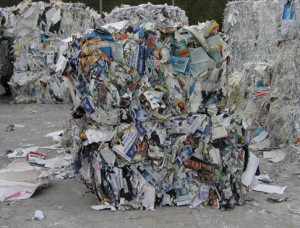Green Futures celebrates its paper anniversary

From Forum For The Future – Katie Shaw
Reading a book, magazine, or picking up the Metro on the tube, it’s probably safe to assume that very few people consider what it has taken to produce the paper in their hands. Abstract concepts such as embedded carbon and embedded water aren’t high on the radar of most folk. But flicking through our latest Green Futures magazines got me thinking about the process the pages go through, from pulp to print.
The story of that process is one that has changed over recent years – and for the better, in the UK at least. Back in 2007, WRAP discovered that magazine publishing in the UK consumed around one million tonnes of paper every year, but just 1-3% of that contained recycled content. Since then, voluntary targets were agreed – and exceeded – between Government and the publishing industries. Newspapers, for example, increased their recycled content to 77.4% in 2010, according to the Confederation of Paper Industries.
We’ve always used recycled paper for the pages of Green Futures magazine (smug pat on the back for us), and one year ago we began working with Arjowiggins Graphic. This paper company prides itself on producing a wide range of crisp, white papers that you wouldn’t even know were recycled, as well as natural paper shades for those who want it to be obvious that they’re ‘doing the right thing’. At Green Futures, we’ve opted for the crisp, white papers of their Cocoon Silk line, with the result that we like to think we produce a pretty darn good-looking magazine using materials that make economic, environmental and aesthetic sense.
Arjowiggins Graphic also has a nifty way of reminding their customers exactly what a difference they make by choosing recycled paper over virgin. The beady-eyed amongst our readers will have noticed that we now publish an Environmental Benefits Statement [EBS] on every issue, detailing the savings we make on each of our print runs by using FSC certified, 100% recycled paper.
In celebration of our recent Paper Anniversary with Arjowiggins Graphic (one year, geddit?!), we’ve produced a cumulative EBS and are thrilled with the results. By printing on Cocoon Silk paper – bright white, silky to the touch and 100% recycled content – over the course of a year, not only have we avoided sending 10,172 kg to landfill, but we’ve also saved 265,627 litres of water, 25,008 kWh of electricity, 1,103 kg CO2 and greenhouse gases and 16,533 kg of wood, compared with if we’d chosen a non-recycled paper.
All of which leaves me with one final question: if you’re considering switching to recycled papers, why wouldn’t you?
From Forum For The Future – Katie Shaw